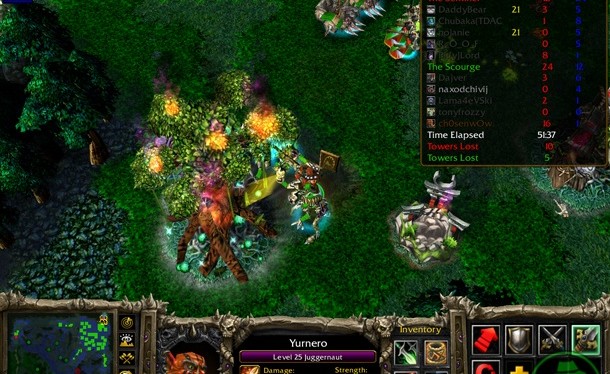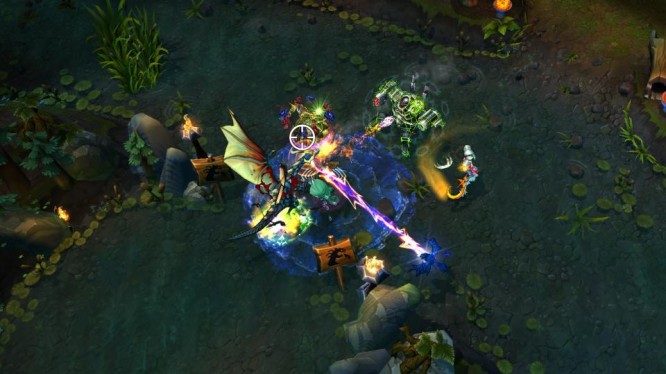

The obvious answer to whether or not League of Legends will last forever should be pretty clear. Nothing, no matter how successful it is will ever last forever, but it’s not likely that any other free-to-play game, at least not another MOBA, will top League of Legends in the near future.
With the League of Legends 2015 World Championship coming to a close this past weekend, it seems like the game’s popularity could keep increasing until there’s nowhere, and no one, left for it to expand to. Even with Dota 2’s massive prize pools every year, it still hasn’t caught up to League of Legends in terms of fan base, number of players, or revenue. So what it is that has allowed League of Legends to be so successful where many other similar games have come and gone without making waves?
Back in 2003, the initial development for what eventually become known as DOTA (Defense of the Ancients) began as a Warcraft III mod. No one ever expected the game to reach the level of influence that it has today. There were plenty of interesting game mods for both StarCraft and Warcraft III, but they were mostly seen as fun mini-games and at most received a modest amount of competitive support. A few friendly tournaments would pop up here and there for DOTA, and the game only ended its career with around 70 recorded cash tournaments, which mostly took place in Asia.

Fast forward to 2009. All of those DOTA players who were addicted to the Warcraft III mod were finally getting a taste of a standalone platform. League of Legends had just opened up its beta client to the world. Sure, the game had all kinds of bugs, balance problems, and it definitely wasn’t that great to look at, but it was an upgrade in functionality when compared with DOTA. The only other standalone MOBA at the time was Demigod, which in comparison simply didn’t understand what the community was looking for. On the other hand, League of Legends brought in former DOTA game designer Steve “Guinsoo” Feak and community manager Steve “Pendragon” Mescon.
Of course, League of Legends was almost nothing like DOTA to those that actually tried both games, and eventually the first true DOTA successor, Heroes of Newerth, came along in 2010 to offer a different option for gamers. However, an entire year of being the only true MOBA, that wasn’t attached to another game, gave League of the Legends the headway it needed to create a gaming icon.
Simply having a game that resembled a MOBA with its own client didn’t necessarily guarantee League of Legends any degree of success. Demigod had the same thing, although it was much more disconnected from its target audience. There were three other key factors that led to the game’s widespread popularity. First, was the introduction of high-speed, broadband Internet. While initially introduced at the beginning of the 2000’s, it wasn’t entirely mainstream until the latter part of the decade. Now more homes than ever had access to fast Internet, at a reasonable cost, and could easily play any multiplayer games without worrying about lag or losing a connection.

The second key component of League of Legend’s success was entering the market as a free-to-play game. Today, a massive amount of PC games advertise themselves as “free-to-play,” but 6 years ago that wasn’t the case. Online PC gaming was dominated by either the subscription or the buy-to-play model. Players were used to having to pay $50 for a game and hope that they actually enjoyed it based on recommendations from reviewers or friends. This meant that anyone with a computer could at least download League of Legends and give it a try. That’s nearly unlimited potential versus trying to convince customers to buy your game before they’ve ever played it. There was no risk on the consumer, it was all on Riot Games. With no real barrier to entry, League of Legends opened itself up to a whole new market of players that generally couldn’t afford games or rarely bought them.
Finally, League of Legends has one of the most lenient PC requirements for any large-scale multiplayer game still on the market. Currently, its recommended specifications are an Nvidia GeForce 8800, 3GHz processor and 2GB of RAM. That was a good PC 10 years ago, and today most bargain bin laptops meet those requirements. Furthermore, the minimum specs are a complete joke and basically any computer that’s DirectX 9.0 capable can run the game, although it looks fairly terrible at the lowest settings.
Combine easier access to high-speed Internet, a free-to-play model, low system requirements, and a need in the market and you’ve created the exact recipe for success. League of Legends isn’t the most popular online game because it’s the best thing ever created, it simply happened to fill very important requirements at a perfect time in the gaming market. World of Warcraft did the exact same thing with MMORPGs, and despite significant improvements to the genre it still reigns supreme.
Online gaming in general simply wouldn’t be where it is today without the huge support of eSports from fans across the world. This push has helped secured a place for many popular games and of course League of Legends is one of them. The ease of entry but difficulty to master makes League of Legends the perfect poster child for eSports. Almost anyone in the world can jump on any computer, log in, and play for free. While there is a slight advantage for players willing to spend some money to afford a large champion pool and multiple rune pages, skill will always be the determining factor that separates the good from the best.

Having a massive eSports following has paid off in dividends for League of Legends. It’s currently the most successful free-to-play game in the world, having earned more than $1 billion in revenue this year. Moreover, it has accrued the second largest combined prize pool this year while hosting more tournaments than any other games except Counter-Strike and Call of Duty.
While the numbers aren’t quite in yet for Worlds 2015, the previous year saw 288 million unique viewers throughout the League of Legends World Championship and 27 million people watched the final match. With more than 67 million players at last count, the combined number of players and viewers makes up a sizeable portion of the world’s population. So, regardless of what amazing multiplayer games come out in the next 5 or so years, it’s unlikely that League of Legends is going anywhere before a major technological breakthrough happens that completely changes the video game industry.




 The Nexus Times: Housing in Wildstar .
The Nexus Times: Housing in Wildstar . WoW Wednesday: World of Warcraft's Lasting Impression .
WoW Wednesday: World of Warcraft's Lasting Impression . What's New with Strife? .
What's New with Strife? . WoW Wednesday: Why WoW is the Only MMO for Me .
WoW Wednesday: Why WoW is the Only MMO for Me . Beta Data: July 25, 2014 .
Beta Data: July 25, 2014 .